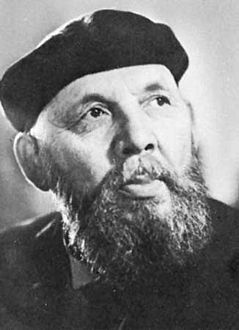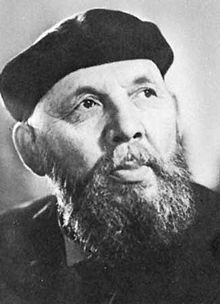
من ويكيبيديا
(بالفنلندية: Frans Eemil Sillanpää)
معلومات شخصية
الميلاد 16 سبتمبر، 1888
هامينكايرو، فنلندا
الوفاة 3 يونيو 1964 (76 سنة)
هلسنكي، فنلندا
الجنسية فنلندي
الحياة العملية
الاسم الأدبي Eemil Syväri تعديل قيمة خاصية (P742) في ويكي بيانات
المدرسة الأم جامعة هلسنكي تعديل قيمة خاصية (P69) في ويكي بيانات
المهنة روائي
اللغة الأم الفنلندية تعديل قيمة خاصية (P103) في ويكي بيانات
اللغات الفنلندية تعديل قيمة خاصية (P1412) في ويكي بيانات
الجوائز
جائزة نوبل في الأدب، 1939
المواقع
IMDB صفحته على IMDB تعديل قيمة خاصية (P345) في ويكي بيانات
P literature.svg بوابة الأدب
تعديل مصدري – تعديل طالع توثيق القالب
فرانس إيميل سيلانبا (بالفنلندية: Frans Eemil Sillanpää)(16 سبتمبر 1888 – 3 يونيو 1964) أحد أشهر أدباء فنلندا.
ابن لوالدين مزارعين من غرب فنلندا. في سنة 1908 بدأ تعليمه العالي في العلوم الطبيعية لكنه انصرف عنها سنة 1913. تحصل على جائزة نوبل للأدب لسنة 1939 حيث تح
ــــــــــــــــــــــــــــــــ

Frans Eemil Sillanpää
From Wikipedia, the free encyclopediaJump to navigationJump to search
| Frans Eemil Sillanpää | |
|---|---|
| Born | 16 September 1888 Hämeenkyrö, Finland |
| Died | 3 June 1964 (aged 75) Helsinki, Finland |
| Occupation | Writer |
| Nationality | Finnish |
| Notable awards | Nobel Prize in Literature |
Frans Eemil Sillanpää (pronunciation (help·info)) (16 September 1888 – 3 June 1964) was one of the most famous Finnish writers and in 1939 became the first Finnish writer to be awarded the Nobel Prize for literature “for his deep understanding of his country’s peasantry and the exquisite art with which he has portrayed their way of life and their relationship with Nature”.[1]
Early life[edit]
Frans Eemil Sillanpää was born into a peasant farming family in Hämeenkyrö. Although his parents were poor, they managed to send him to school in Tampere. At school Sillanpää was a good student and with aid from his benefactor Henrik Liljeroos he entered the University of Helsinki in 1908 to study medicine.[2][3] Here his acquaintances included the painters Eero Järnefelt and Pekka
Halonen, composer Jean Sibelius and author Juhani Aho.[2]

Career[edit]
Five years later, in 1913 Sillanpää moved from Helsinki to his old home village and devoted himself to writing.[4] In 1914 Sillanpää wrote articles for the newspaper Uusi Suometar.[2] In 1916 Sillanpää married Sigrid Maria Salomäki, whom he had met in 1914.[2]
By principle, Sillanpää was against all forms of violence and believed in scientific optimism.[5] In his work he portrayed rural people as living united with the land.[2]
The novel Hurskas kurjuus (Meek Heritage) (1919) depicted the reasons for Finnish Civil War, and despite its objectivity, was controversial at the time.[6]
Sillanpää won international fame for his novel Nuorena nukkunut (translated to English as The Maid Silja) in 1931.
In 1939, he was awarded the Nobel Prize in Literature “for his deep understanding of his country’s peasantry and the exquisite art with which he has portrayed their way of life and their relationship with Nature.”[7] A few days after he received the prize, talks between Finland and Soviet Union broke down and the Winter War began.[3][8] Sillanpää donated the golden medal to be melted for funds to aid the war effort.[8]
Before the Winter War, Sillanpää wrote the lyrics for what is known as Sillanpään marssilaulu to lift his spirits when his eldest son Esko was partaking in military practices at Karelian Isthmus.[9]
In 1939 his wife Sigrid died of pneumonia leaving eight children with Sillanpää.[3] Some time after, Sillanpää married his secretary Anna von Hertzen (1900-1983) and traveled to Stockholm to receive the Nobel prize.[3]
In 1941 Sillanpää divorced his wife Anna. His alcoholism and other ailments needed hospital treatment. In 1943 he returned to public life as a bearded old ‘Grandpa Sillanpää’. His radio appearances, especially his tradition of talking on Christmas Eve from 1945 to 1963 became very popular.[10]
The asteroid 1446 Sillanpää, discovered on January 26, 1938 by the renowned Finnish astronomer and physicist Yrjö Väisälä, was named after him.
Death[edit]
Sillanpää died on 3 June 1964 in Helsinki aged 75.
Works[edit]
Sillanpää sitting for the sculptor Mauno Oittinen in 1931.
- Elämä ja aurinko (1916)
- Ihmislapsia elämän saatossa (1917)
- Hurskas kurjuus (translated as Meek Heritage) (1919)
- Rakas isänmaani (1919)
- Hiltu ja Ragnar (1923)
- Enkelten suojatit (1923)
- Omistani ja omilleni (1924)
- Maan tasalta (1924)
- Töllinmäki (1925)
- Rippi (1928)
- Kiitos hetkistä, Herra… (1930)
- Nuorena nukkunut (translated as The Maid Silja) (1931)
- Miehen tie (1932)
- Virranpohjalta (1933)
- Ihmiset suviyössä (translated as People in the Summer Night) (1934)
- Viidestoista (1936)
- Elokuu (1941)
- Ihmiselon ihanuus ja kurjuus (1945)
Films[edit]
Poststamp released in 1980 in honour of Sillanpää.
Numerous of his works have been made into films:
- Nuorena nukkunut, Teuvo Tulio. 1937
- One Man’s Faith, Nyrki Tapiovaara and Hugo Hytönen. 1940
- Ihmiset suviyössä, Valentin Vaala. 1948
- Poika eli kesäänsä, Roland af Hällström. 1955 (based on novel Elämä ja aurinko)
- The Harvest Month, Matti Kassila. 1956
- Silja – nuorena nukkunut, Jack Witikka. 1956
- The Glory and Misery of Human Life, Matti Kassila. 1988



